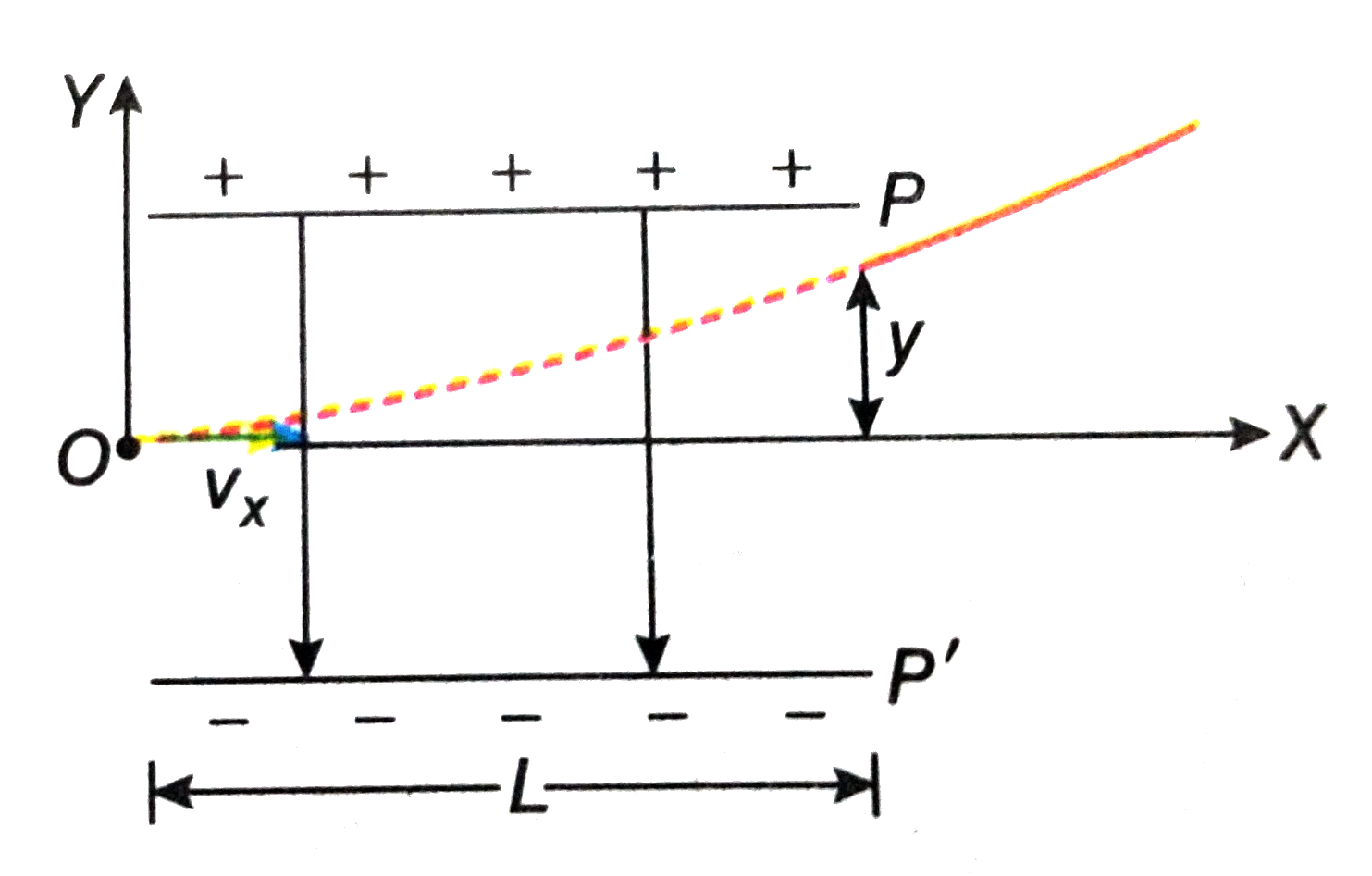An electron of charge and mass kg, travelling along the X-axis with a uniform velocity of , enters in a uniform electric field of acting perpendicular to the X-axis. If the electric field extends over a length of 2 cm along the X-axis, what will be the deflection of the electron along the direction of the field when it emerges from it?Solution in Bengali
Here, electric field V/m is directed along Y-axis and effective upto a length L = 2 cm along X -axis [Fig. 2.31].
An electron is projected from O with an initial speed of m/s along + X-axis. Charge of the electron, C and mass of the electron, .

If we consider the motion of the electron along Y-axis, the force on the electron due to the electric field,
Acceleration of the electron along Y-axis,
Let the deflection of the electron when it is emitted from the electric field be y and the time taken to cover that vertical distance be t.
or, ...(1)
Along X-axis, force on the electron,
Acceleration,
Velocity, (constant)
Now distance covered along X-axis in time t is L =
..(2)
From equation (1) and (2),
m
cm
Thus, required deflection is 3.51 cm.
Topper's Solved these Questions
- BOOK - CHHAYA PUBLICATIONCHAPTER - ELECTRIC FIELDEXERCISE - SECTION RELATION QUESTIONS50videos
ELECTRIC FIELD
- BOOK - CHHAYA PUBLICATIONCHAPTER - ELECTRIC FIELDEXERCISE - HIGHER ORDER THINKING SKILL QUESTIONS33videos
ELECTRIC FIELD
- BOOK - CHHAYA PUBLICATIONCHAPTER - ELECTRIC ENERGY AND POWEREXERCISE - CBSE SCANNER7videos
ELECTRIC ENERGY AND POWER
- BOOK - CHHAYA PUBLICATIONCHAPTER - ELECTRIC POTENTIAL EXERCISE - CBSE Scanner13videos
ELECTRIC POTENTIAL
Similar Questions
State Coulomb's law regarding the force of interaction between two point charge. Define the unit of charge from this law.
01:37View SolutionTwo charges, +qand−q are separated by a distance d. At which points will the resultant electric field intensity be directed parallel to the line joining the charges ?
01:58View SolutionA light bulb is rated 100 W for 220 V ac supply of 50 Hz. Calculate
the resistance of the bulb ,02:36View SolutionA test charge q is moved without acceleration along the path from A to B from B to C in electric field E as shown in fig.

(i) Calculate the potential difference between A and C.03:45View SolutionAn electron beam projected along positive x-axis deflects along the positive y-axis. If this deflection is caused by a magnetic field, what is the direction of the field?
07:44View SolutionA positively charge particle moving along x -axis with a certain velocity enters a uniform electric field directed along positively y-axis. Its
05:26View SolutionAn electron is moving with constant velocity along x-axis. If a uniform electric field is applied along y-axis, then its path in the x-y plane will be
08:48View SolutionThe magnitude of an electric field along x-axis is 1V.m^(-1) and in the same region the magnitude of a magnetic field along y-axis is 10^(-6) T . What should be the velocity of an electron in that region so that it will continue to move with uniform velocity along z-axis without suffering any deviation?
View SolutionAn electron (charge =-1.6xx10^(-19)C , mass =9.1xx10^(-31)kg ) enters a uniform electric field of magnitude 10V.m^(-1) with velocity 10^(6)m.s^(-1) normally to the direction of the field. If it covers 10 cm path inside that electric field, determine the displacement of the electron normal to the direction of its initial velocity.
07:05View SolutionIn a region, a uniform electric field of 100V.m−1 is acting along x-axis and a uniform magnetic field of 10−4T along y-axis. If an electron enters that region along z-axis with a velocity of 105m.s−1, determine the magnitude and direction of the force acting on it. Charge of an electron =1.6×10−19C.
View SolutionAn electron is moving along +x direction with a velocity of 6×106ms−1 . It enters a region of uniform electric field of 300 V/cm pointing along + y direction. The magnitude and direction of the magnetic field set up in this region such that the electron keeps moving along the x direction will be :
02:14View SolutionAn electron in moving along positive x-axis in the presence of uniform magnetic field along positive y-axis. What is the direction of the force acting on it ?
03:58View SolutionAn electron is moving along +x direction with a velocity of 6×106ms−1 . It enters a region of uniform electric field of 300 V/cm pointing along + y direction. The magnitude and direction of the magnetic field set up in this region such that the electron keeps moving along the x direction will be :
View SolutionA positively charged particle moving along x-axis with a certain velocity enters a uniform electric field directed along positive y-axis. Its
View SolutionAn electron is moving along X-axis in a magnetic field acting along Y-axis. What is the direction of magnetic force acting on it?
03:39View Solution
